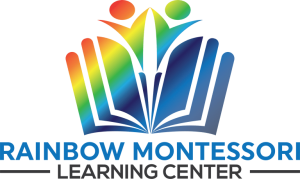The Montessori Method
At Rainbow Montessori Learning Center, we are committed to creating a learning environment that is free of negative input and centered around success-oriented, self-teaching, self-correcting educational experiences. Your child will have the opportunity to learn through doing and through experimentation. This is accomplished by creating an environment that fosters children to find their own purpose and explore their educational and personal path as they learn to master new ideas and new skills in a manner that engenders the pleasure of discovery and exploration, rather than conventional mass production or memorization of content.
Because we believe in the importance of instilling this type of agency in learners, our teachers are referred to as “directors” because we do not consider their primary role to be that of teacher or sole disseminator of knowledge, but rather as facilitators who provide assistance to guide your child in their learning process without intervening too greatly. By assuming this pedagogical stance, students are better able to develop attitudinal skills such as self-reliance and personal responsibility, along with critical thinking skills.
History Of The Montessori School
The Montessori method was developed by Italian physician Maria Montessori, who abandoned her medical career to focus on childhood education and development. The first Montessori School (Casa dei Bambini) was opened in Rome in 1907. Over time, Montessori developed a theory that approached education as a vehicle for developing world peace. She believed children who were given the opportunity to develop in a manner governed by their own inner laws of personal development would play an essential role in the development of a more peaceful civilization.
The Montessori approach to education has since given children agency in deciding what materials they want to explore and allows them to use materials of their own selection in the moments they are learning. It also creates an environment where children interact with students outside their typical age group. As a result, students develop improved skills in focus, coordination, discipline, determination, and self-confidence, as well as interpersonal skills like community-building and mutual respect for peers.
The Four Planes of Development
Montessori’s approach to education was grounded in what she observed to be the four planes of human development. The first plane takes place between birth and 6 years of age, the second from the ages of 6 to 12, the third from 12 to 18, and the final plane from the ages of 18 to 24. Within each of these planes, Montessori saw distinct modes of learning, unique characteristics, and developmental imperatives that required specialized education approaches.
The First Plane
The first plane occurs between birth and six years and is characterized by dramatic physical and psychological development in the child. This plane is sensory, concrete, and grounded in the development of self and personal independence through learner engagement. Montessori referred to the child’s ability to assimilate sensory and stimulus information from things such as language, sense, and cultural practices as being tied to the child as having an absorbent mind. Montessori believed this absorbent mind was unique to this plane and an attribute that began fading around the age of six years old. Montessori also referred to the child’s heightened sensitivity to specific stimuli during this plane as “sensitive periods”, which is why Montessori classrooms design their learning environment to match the periods when children are especially sensitive to the following:
- Sensory Refinement, which generally takes place from birth to approximately 4 years of age
- Language Acquisition, which develops from birth to approximately 6 years of age
- Order, which develops from 1 to 3 years of age
- Interest in small objects, which develops from approximately 18 months to 3 years of age
- Social behavior, which develops from approximately 2 ½ to 4 years of age
The Second Plane
The second plane, which occurs approximately from 6 to 12 years of age is characterized by physical and psychological changes. Physical changes include things such as losing baby teeth or growing taller, whereas psychological changes include things like the tendency to socialize and work in groups, along with heightened abilities to engage with imagination and reason. Montessori believed this plane to be the period when a child’s moral sense, intellectual independence, and understanding of social organization were formed.
The Third Plane
The third plane, which occurs between the ages of 12-18 is characterized by the physical changes associated with puberty, along with a psychological shift, characterized by a wide range of markers, including instability, creativity, a heightened need for personal validation, and a sense of justice or fairness. Montessori believed this plane marked the critical development of constructing an adult self that can engage in society.
The Fourth Plane
The fourth plane occurs between the ages of 18-24 and is marked by a general ability to develop economic independence and having the requisite skills to fully embrace a lifetime of study and engagement to positively impact the world.
A Philosophy Dedicated To Learning
At Rainbow Montessori Learning Center, we are committed to helping your child receive the individualized support and guidance they need to explore the world and develop a love of learning that extends naturally from their innate curiosity and pursue their intrinsically motivated interests to better understand the world in their own unique manner. Contact us today to schedule a professional childcare consultation and learn more about our resources and educational philosophy.
Let’s Talk
We would love to hear from you. Call Rainbow Montessori Learning Center today to schedule a professional childcare consultation and learn more about our resources and educational philosophy.
